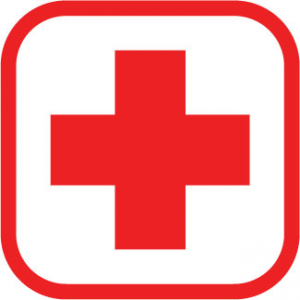Fall is a season where many of us head out to enjoy the outdoors. Crisp air, colorful leaves, deer in rut, and clear mountain streams lure us to nature. Unfortunately, there are times when things go sideways on day hikes and canoe trips. When they do, you’ll need knowledge, skills, and resources to get home safely.
The goal of wilderness survival is simple… to effect self-rescue or be found alive. Even “minor” injures in a 72 hour scenario can decrease your chances of meeting that goal.
Self-aid should become a top priority on your skills list. Why?
You’re likely to come in contact with sharp stuff, hot stuff, slippery stuff, and/or stinging stuff on outings. I rarely leave the woods without one of these most common wilderness injuries:
- Cuts/Abrasions
- Burns
- Breaks/Strains/Sprains
- Bites/Stings
- Blisters
You may choose to carry a first-aid kit to treat these injuries. The problem with a dedicated first-aid kit (pre-made or homemade) is that they take up space and typically have only on use. Let me state upfront, if you require daily medication for health issues, by all means, be sure to pack enough of your meds.
Can your 10 piece kit double as a self-aid/first-aid kit? Indeed it can!
First, here are the 10 essential items that should go with you on every trip to the woods…
The 10 C’s of Survivability (10 Piece Kit)
- Cutting tool
- Combustion device
- Container
- Cover
- Cordage
- Cotton bandana
- Cargo tape
- Cloth sail needle
- Candling device
- Compass
Look beyond the obvious uses for these 10 items – shelter, fire, navigation, water, etc., etc. With a little creativity and practice, your 10 C’s can effectively treat each of the most common injuries in a 72 hour wilderness survival scenario.
Here’s how…
(Adapted from Brian Manning’s hand-out and Jason Hunt’s class on wilderness self-aid at The Pathfinder School)
Cuts and Abrasions
- Cutting tool – use knife to remove debris from wounds
- Combustion device – sterilize tools
- Container – irrigate and wash wound with water
- Cover – (drum liner, plastic tarp) bandage and cover wounds
- Cordage – tourniquet as a last resort
- Cotton bandana – wipe/clean wound, bandages, dressings, tourniquet
- Cargo (duct) tape – all-purpose Band Aid, DIY butterfly Band Aid
- Cloth sail needle – remove debris from wound and stitch/suture in extreme cases
- Compass – good compasses have a magnifying lens that can be used to inspect wounds closely
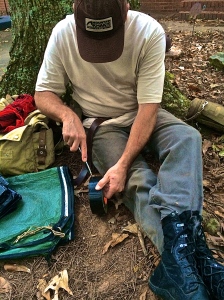
Using your knife to cut a duct tape butterfly bandage. Keep your knife outside the Triangle of Death. You don’t need another wound.
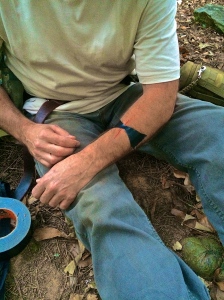
Pull the wound together after securing one side of the bandage to the skin. The cut should be pinched together slightly. This is a temporary fix.

Shemaghs make great slings. Get one that is 100% cotton.
Breaks, Sprains, and Strains
- Container – water bottle used as a hot or cold pack
- Cordage – splint wraps, slings (add padding)
- Cargo tape – immobilize limbs by taping makeshift splints in place
- Cotton bandana or shemagh – slings, splint wraps, padding under splints (tie smaller bandanas together for longer slings)
- Cover (drum liner) – water collection (cold/hot pack), splint wraps, slings
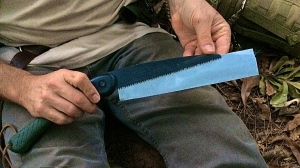
If using a folding saw or machete as a makeshift splint, tape the cutting edge before taping it to your limb.
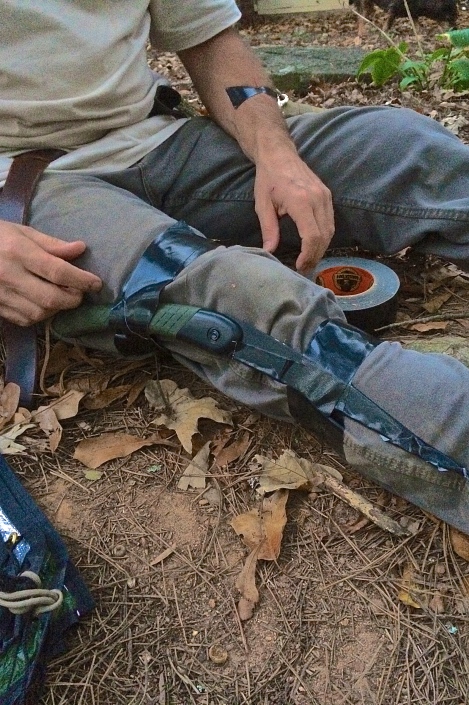
Immobilizing a limb. Add padding under your splint before taping.
Burns
- Cutting tool – remove debris and clean burns
- Container – use to pour water for irrigation, stop the burning process, and cold pack
- Cotton bandana – cover burn loosely, retain moisture on burn
- Cloth sail needle – clean burns
- Cover (drum liner) – cover and protect burns
- Compass – mirror and magnifying lens used to inspect burns and hard-to-reach areas on the body
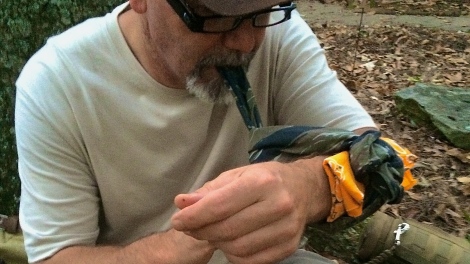
Bites and Stings
- Cutting tool – knife to scrape/remove stingers and splinters
- Container (water bottle) – cold compress to reduce swelling, irrigation – in the case of venomous snake bites, keep location cool, immobilize, and get medical help ASAP.
- Cargo tape – DIY Band Aids, bandage tape, remove stinger
- Cloth sail needle – remove stinger or splinter
- Compass – mirror and magnifying lens used to locate and inspect hard to reach areas on the body (i.e. – tick removal and bites)
- Cotton bandana – Band Aid/bandage material, pressure dressing
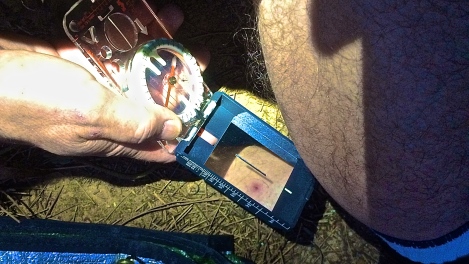
Sighting mirror on compass used to inspect embedded tick on the back of the calf in the dark. A headlamp frees both hands for the task.
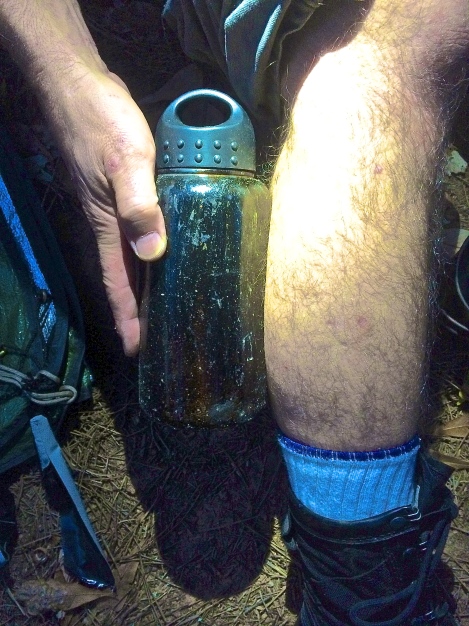
Cold water in a water bottle
Blisters
- Cargo tape – cover/shield developing hot spots
- Cloth sail needle – pop blister at base to drain
- Container (water bottle) – irrigate and clean area
Additional self-aid uses for the 10 piece kit
- Your candling device (head lamp/flashlight) can be used for inspection and treatment at night with all the common injuries.
- Metal water bottle and cup is useful for preparing infusions, decoctions, and sterilization of your knife or needle before cleaning wounds.
- Besides using a tarp/emergency space blanket for core temperature control (CTC), these items can also serve as a stretcher, water collection device, and sling material.
- Use your pack for immobilization and elevating injured limbs and or dealing with shock.
- And of course, a proper fire kit affords you the ability to maintain CTC, heat natural medicinals, and heat compresses.
Your 10 piece kit should always accompany you on wilderness adventures. As you can see, these multi-purpose tools have many redundant uses. Heck, the 10 C’s of Survivability should go with you no matter where you’re headed.
Keep Doing the Stuff of Self-Reliance,
Todd
This article was originally published at Ready Nutrition™ on October 13th, 2014


